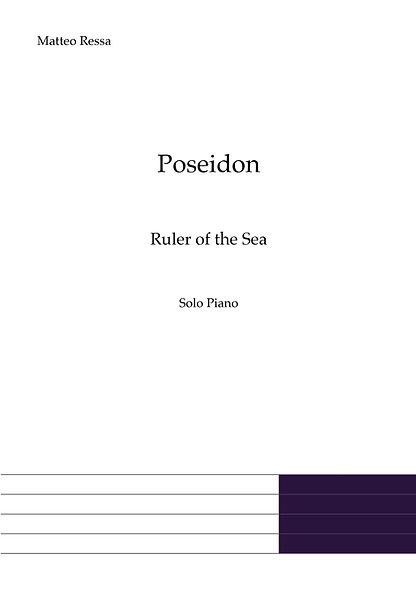%20-%20Cover.jpg)
Poseidon
Ruler of the Sea
Solo Piano score. Available as digital (PDF) score, with physical copies available for purchase by completing a Printed Score Order. The physical edition includes a duplication of the last page on a seperate sheet to help with page turns.
You may only print/distribute the number of copies you purchase.
£8.99
£13.99
Instrumentation
Solo Piano
Duration
ca. 8 minutes
About the Work
Poseidon: Ruler of the Sea is a work intended to capture the ebb and flow of the ocean. Initially conceived as a work for piano, I later expanded the work for small orchestra, before taking its final form for full symphony orchestra.
Poseidon was one of the principal gods of the Ancient Greeks. He was associated with calming the seas for safe travel, trade, and warfare, as well as being responsible for the creation of islands. Conversely, the god (sometimes referred to by his Roman name Neptune) would punish those who crossed him by causing storms, shipwrecks, and earthquakes.
Throughout this piece, I attempted to capture the types of feeling had atop the ocean by contrasting between majestic and powerful passages alongside sections of a more mysterious and sinister character. The piece utilises a huge range, capturing the scope of the sea. I wanted to replicate the form of waves through the dynamics in the piece. With each section pushing from very quiet towards a loud release, and then stopped from being fully realised until the glorious finale. The quiet ending is intended to reflect the endless nature of the ocean, with the music descending into the waves.
Performance Note
The piece should be played with heavy rubato throughout, especially with the opening and when the same material returns at b. 133. Space should be given at the ends of phrases in these sections. The bracketed notes in b. 6-7 can be played in place of the lower notes in the right hand if the interval is too large.
The A tempo - Appasionato (b. 147) should represent the peak of the music, both dynamically and narratively. Therefore, it is vital that a degree of restraint is shown in previous forte or fortissimo sections. This section also represents a particular challenge due to the multitude of voices occurring. The lower bass notes should sound thunderous, with the subsequent semiquaver pattern sounding almost like an echo of storm-waves. This is in stark contrast to the simultaneous right-hand demisemiquaver pattern, representing splattering of sea spray or rain. Despite this, the melody should rise above the texture and be clearly heard.